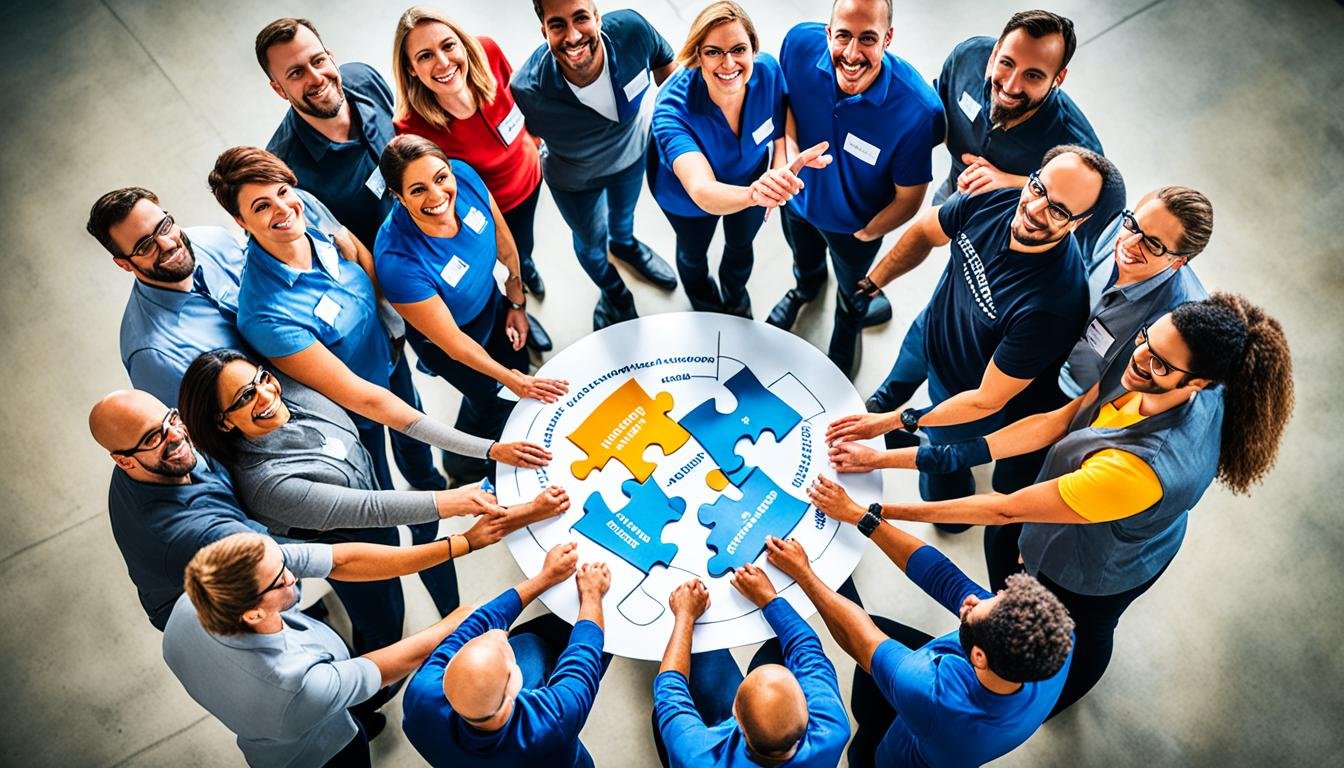A Guide to HR Workforce Development
Welcome to our comprehensive guide on HR workforce development. In today’s rapidly changing business landscape, organizations must invest in their most valuable asset: their employees. HR workforce development encompasses various strategies aimed at enhancing employee skills and driving business success. From HR training programs to talent development and leadership initiatives, this guide will explore the essential components of HR workforce development and provide practical insights for organizations seeking to maximize their workforce’s potential.
Key Takeaways:
- HR workforce development is crucial for employee growth and organizational success.
- Effective HR training programs and talent development initiatives contribute to workforce management and professional development.
- Leadership development, performance management, and skills development are key areas of focus for HR workforce development.
- Career growth opportunities are essential to attract and retain top talent within organizations.
- By investing in HR workforce development, companies can create a skilled and motivated workforce that drives long-term growth and competitiveness.
Understanding the Importance of HR Workforce Development
HR workforce development plays a crucial role in the success of organizations. It focuses on employee training and development, business development, and creating learning-based organizations. By investing in employee training and development, companies can enhance their workforce’s skills and capabilities, leading to improved performance and business growth.
Employee training is a vital component of HR workforce development. It equips employees with the necessary knowledge, skills, and resources to perform their job tasks effectively. Through targeted training programs, organizations can address skill gaps, improve job performance, and foster a culture of continuous learning.
Effective employee training programs provide numerous benefits, such as improved productivity, increased employee satisfaction, reduced turnover, and enhanced competitiveness in the market.
Furthermore, HR workforce development is closely linked to business development. By aligning employee training needs with strategic business goals, organizations can drive innovation, facilitate expansion into new markets, and adapt to changing industry trends. Training programs that focus on developing leadership skills, fostering teamwork, and promoting problem-solving abilities contribute to overall business success.
Creating Learning-Based Organizations
HR workforce development also aims to create learning-based organizations. These organizations prioritize continuous learning and growth, fostering an environment that encourages employees to acquire new knowledge and develop new skills. Learning-based organizations leverage employee expertise and facilitate knowledge sharing to drive innovation and foster a culture of curiosity and exploration.
Companies that embrace a learning-based approach to HR workforce development are better equipped to adapt to market changes and remain competitive. They empower employees to take ownership of their development, providing them with the necessary tools and resources to pursue professional growth opportunities.
Ultimately, HR workforce development is not just about training employees; it is about investing in the organization’s most valuable asset—its people. By nurturing employee talent and fostering a culture of continuous learning, organizations can cultivate a skilled, motivated workforce that contributes to long-term growth and success.
Effective Strategies for HR Workforce Development
HR workforce development requires the implementation of effective strategies to enhance employee skills and drive organizational success. This section explores various training and development theories, workplace learning interventions, the development of soft skills, giving effective presentations, and practical exercises for employee training interventions. By applying these strategies, companies can design and implement impactful training programs that empower employees to reach their full potential.
Training and Development Theories
Training and development theories provide valuable insights into how individuals acquire knowledge and skills. By understanding these theories, HR professionals can design training programs that align with the principles of adult learning. Some prominent theories include:
- Social Learning Theory: Emphasizes the importance of observational learning and modeling behaviors.
- Cognitive Load Theory: Focuses on optimizing learning by managing the cognitive load on learners.
- Experiential Learning Theory: Highlights the significance of hands-on experiences and reflection in the learning process.
Workplace Learning Interventions
Workplace learning interventions aim to create a continuous learning culture within organizations. They provide employees with opportunities to acquire new knowledge, skills, and competencies directly applicable to their jobs. Some effective workplace learning interventions include:
- Mentoring and Coaching Programs: Pairing experienced employees with newcomers to foster knowledge transfer and skill development.
- Job Rotation: Allowing employees to gain exposure to different roles and functions within the organization to broaden their skillsets.
- Communities of Practice: Facilitating knowledge sharing and collaboration among employees with shared interests or expertise.
Development of Soft Skills
Soft skills are essential for employee success in the modern workplace. They encompass a range of interpersonal and communication abilities that enable individuals to work effectively with others. HR workforce development should prioritize the development of soft skills such as:
- Communication: Enhancing written and verbal communication skills to improve interactions with colleagues, clients, and stakeholders.
- Teamwork: Promoting collaboration, cooperation, and effective team dynamics to achieve common goals.
- Problem-solving: Equipping employees with critical thinking and analytical skills to identify and solve complex problems.
Effective Presentations
Effective presentations are crucial for conveying information and engaging audiences. HR professionals should provide employees with training on delivering impactful presentations. Key elements to focus on include:
- Clear and Concise Messaging: Ensuring information is presented in a straightforward manner to facilitate understanding.
- Engaging Visuals: Incorporating visuals such as charts, graphs, and images to enhance audience engagement and comprehension.
- Confidence and Delivery: Training employees on public speaking techniques, body language, and effective use of voice.
Employee Training Interventions
Employee training interventions should be designed with specific learning objectives in mind. They should provide practical experiences that enable employees to apply their newly acquired knowledge and skills in real-world scenarios. Effective employee training interventions include:
“Tell me and I forget. Teach me and I remember. Involve me and I learn.” – Benjamin Franklin
By implementing hands-on exercises, simulations, case studies, and role-playing activities, employees can gain practical experience and deepen their understanding of training concepts.
| Training Strategy | Description |
|---|---|
| On-the-Job Training | Providing employees with practical, hands-on experience under the guidance of experienced colleagues or mentors. |
| E-Learning | Offering online training modules, courses, or webinars that employees can access at their convenience. |
| Team-Based Learning | Fostering collaboration and knowledge sharing through group projects or problem-solving activities. |
| External Workshops and Seminars | Encouraging employees to attend external training events or conferences to gain industry insights and expand their professional networks. |
Strategic Workforce Planning for HR Development
Strategic workforce planning is a critical component of HR development. It enables organizations to address workforce gaps, optimize workforce size and configuration, manage labor costs, ensure workforce agility, and mitigate workforce risks. By aligning HR strategies with organizational goals, strategic workforce planning helps create a robust and future-ready workforce.
The Importance of Strategic Workforce Planning
Strategic workforce planning plays a vital role in HR development by:
- Identifying and addressing workforce gaps to ensure the availability of the right talent
- Optimizing workforce size and configuration to meet organizational needs
- Managing labor costs effectively without compromising productivity
- Ensuring workforce agility to adapt to changing business environments
- Mitigating workforce risks by identifying potential challenges and implementing proactive measures
By considering these factors, organizations can align HR strategies with organizational goals and foster a workforce that is well-prepared to tackle future challenges and leverage new opportunities.
Aligning Organizational Goals with Workforce Planning
Strategic workforce planning involves aligning the organization’s goals with the desired workforce configuration. This entails understanding the organization’s future needs, identifying the skills and competencies required, and mapping these requirements to the existing workforce. By aligning workforce planning with organizational goals, HR can focus on developing the right talent and making informed decisions to optimize the workforce.
“Strategic workforce planning helps organizations align HR strategies with organizational goals, ensuring the right talent is available to drive success.” – HR Executive
The Benefits of Strategic Workforce Planning
Strategic workforce planning offers numerous benefits, including:
- Optimizing performance and productivity through the availability of skilled and competent employees
- Reducing labor costs by efficiently managing workforce size and allocation
- Enhancing workforce agility to adapt to market fluctuations and business demands
- Mitigating workforce risks by proactively addressing potential challenges
- Aligning HR strategies with organizational goals to drive overall success
By strategically planning and managing the workforce, organizations can achieve their HR development goals and create a competitive advantage in the marketplace.
Benefits of HR Workforce Development
HR workforce development plays a crucial role in organizations, offering numerous benefits that contribute to their success and competitiveness.
- Addressing demographic changes and closing skills gaps: In a rapidly evolving workforce, HR workforce development helps organizations adapt to demographic shifts and ensure they have the necessary skills to thrive in the future.
- Reducing costs through optimized workforce size: By investing in HR workforce development, organizations can optimize their workforce size, reducing unnecessary labor costs and enhancing operational efficiency.
- Enhancing talent management: HR workforce development enables organizations to attract, retain, and develop top talent. By investing in employees’ skills and career growth, companies can create a motivated workforce that contributes to long-term success.
- Preparing for the future: With dynamic changes in technology and the business landscape, HR workforce development helps organizations stay ahead by equipping employees with the skills needed to navigate future challenges.
- Providing workforce flexibility: HR workforce development fosters a flexible workforce that can effectively adapt to changing needs, ensuring agility and resilience in times of uncertainty.
- Mitigating risks: By actively investing in HR workforce development, organizations can mitigate risks associated with workforce challenges, such as skills gaps, talent shortages, and succession planning.
- Aligning workforce strategies with organizational goals: HR workforce development aligns the strategies for developing and managing the workforce with the overall goals and objectives of the organization, facilitating organizational goal alignment and maximizing the impact of workforce initiatives.
Overall, HR workforce development offers a comprehensive range of benefits, spanning from addressing demographic changes and reducing costs to enhancing talent management and aligning workforce strategies with organizational goals. By prioritizing HR workforce development, organizations can build a skilled, adaptable, and future-ready workforce that drives sustained success.
The Process of HR Workforce Development
The process of HR workforce development is a strategic endeavor that involves various stages aimed at aligning organizational strategy with the development of the workforce. By following a systematic approach, companies can ensure that their HR development efforts effectively contribute to achieving the organization’s goals and objectives.
Strategic Workforce Planning Framework
Strategic workforce planning forms the foundation of the HR workforce development process. This framework involves analyzing the organization’s overall strategy and identifying the workforce capabilities needed to support its execution. By understanding the skills, knowledge, and competencies required, HR professionals can develop a comprehensive plan for workforce development.
Workforce Analysis
Workforce analysis plays a crucial role in HR workforce development. It involves evaluating the current workforce’s skills, identifying skill gaps, and assessing future workforce needs. This analysis provides valuable insights that guide the development of targeted development programs, ensuring that employees acquire the necessary skills to meet organizational demands.
Action Plan Development
Based on the workforce analysis, HR professionals develop an action plan that outlines specific development initiatives and activities. This plan includes a roadmap for training programs, coaching and mentoring opportunities, and other interventions aimed at enhancing employee skills and competencies. The action plan serves as a guide for implementing and managing the HR development initiatives effectively.
Implementation
After developing the action plan, the next step in the HR workforce development process is its implementation. This involves executing the planned activities, which may include conducting training sessions, providing ongoing coaching and feedback, and facilitating mentorship programs. The implementation phase ensures that the development initiatives are rolled out effectively to the targeted employees.
Monitoring and Evaluation
To measure the effectiveness of HR development efforts, continuous monitoring and evaluation are essential. HR professionals assess whether the planned activities have achieved the desired outcomes and identify areas for improvement. Through monitoring and evaluation, companies can make data-driven decisions, adapt their approach if needed, and refine their HR workforce development strategies.
| Stage | Description |
|---|---|
| Strategic Workforce Planning Framework | Analyze the organization’s strategy and identify workforce capabilities required |
| Workforce Analysis | Evaluate current workforce skills, identify gaps, and assess future needs |
| Action Plan Development | Create a detailed plan for implementing development initiatives |
| Implementation | Execute planned activities, including training and mentorship programs |
| Monitoring and Evaluation | Continuously assess the effectiveness of HR development efforts and make necessary adjustments |
Key Models for HR Workforce Development
HR workforce development models provide structured frameworks for planning and implementing HR development initiatives. Two prominent models in this field are the HCI model and OPM’s workforce planning model.
HCI Model
The Human Capital Institute (HCI) has developed a comprehensive model for HR workforce development. It focuses on aligning organizational strategy with talent management and development. The HCI model emphasizes the importance of identifying critical competencies, assessing workforce capabilities, and implementing targeted training programs to bridge skills gaps.
OPM’s Workforce Planning Model
The U.S. Office of Personnel Management (OPM) offers a workforce planning model that aids HR professionals in developing effective strategies for workforce optimization. The model emphasizes aligning workforce planning with organizational goals, strategically managing human capital, and ensuring workforce flexibility to respond to changing business needs.
“The HCI model and OPM’s workforce planning model serve as valuable guides for organizations seeking to enhance their HR workforce development initiatives.”
Practical case studies demonstrate the successful implementation of these models in various organizations. These case studies showcase how companies have utilized the HCI and OPM models to align their workforce development goals with organizational objectives, improve employee skills, and drive business growth.
Practical Case Studies
Let’s explore some practical case studies highlighting the effective utilization of HR workforce development models:
| Company | Model Used | Achievements |
|---|---|---|
| ABC Corporation | HCI Model | Implemented targeted training programs based on competency assessments, resulting in a 20% increase in employee productivity. |
| XYZ Inc. | OPM’s Workforce Planning Model | Aligned workforce configuration with organizational goals, optimizing labor costs and increasing workforce flexibility by 30%. |
| DEF Enterprises | HCI Model | Developed a leadership development program based on the HCI model, resulting in a 25% increase in employee retention rates. |
These case studies serve as real-world examples of how organizations can leverage HR workforce development models to achieve their talent management and development objectives.
Incorporating Employee Development into the Organizational Culture
To effectively incorporate employee development into the organizational culture, companies should prioritize continuous learning and foster a growth mindset. By creating a culture that values and invests in employee growth, organizations can develop a highly skilled and motivated workforce. This section explores key strategies for integrating employee development into the organizational culture, including:
- Create Clear Career Paths: Establishing transparent and well-defined career paths helps employees understand their growth opportunities and motivates them to enhance their skills and performance.
- Provide Diverse Learning Opportunities: Offering a range of learning opportunities, such as workshops, online courses, conferences, and mentorship programs, allows employees to gain new knowledge and skills in various areas.
- Integrate Development into Performance Management: Linking employee development goals to performance management processes ensures that development efforts are aligned with organizational objectives. Regular feedback, coaching, and goal-setting conversations help employees track their progress and identify areas for improvement.
By incorporating these strategies into the organizational culture, companies demonstrate their commitment to employee growth and create an environment that supports continuous learning and development. This fosters a sense of loyalty, satisfaction, and engagement among employees, leading to increased productivity and improved organizational performance.
“By creating a culture that values and invests in employee growth, organizations can develop a highly skilled and motivated workforce.”
Case Study: Company X’s Employee-First Culture
Company X has successfully embedded employee development into its organizational culture by prioritizing the growth and well-being of its employees. Through a comprehensive employee-first approach, they have fostered a culture that values continuous learning and professional growth.
The company provides regular training sessions and workshops on various topics, including technical skills, leadership development, and personal growth. It encourages employees to take ownership of their learning by offering access to online learning platforms and supporting further education through reimbursement programs.
Additionally, Company X has established a structured career path framework that defines different roles and responsibilities within the organization. This enables employees to map their career progression and proactively work towards their professional goals.
Company X also integrates development discussions into its performance management process. Managers hold regular performance reviews that focus not only on past achievements but also on an individual’s future development opportunities. These conversations provide employees with valuable feedback and guidance to enhance their performance and skill set.
As a result of their employee-first culture, Company X has experienced improved employee satisfaction and retention rates. Employees feel valued and supported in their growth journey, leading to a highly motivated workforce that is committed to achieving the company’s goals.
The Role of Managers in HR Workforce Development
Managers play a crucial role in the success of HR workforce development initiatives. Their support and active involvement are key to creating a culture of continuous learning and fostering employees’ growth. Through various actions and responsibilities, managers contribute significantly to the development and enhancement of their teams’ skills and capabilities.
One of the essential roles of managers is to provide the necessary support and guidance to their team members. By offering encouragement, resources, and assistance, they create an environment that values individual development and empowers employees to expand their knowledge and skills. This support is crucial in ensuring that HR workforce development efforts are effectively implemented and sustained.
Growth conversations form the foundation for personalized development plans. Managers should engage in regular discussions with their team members regarding their career aspirations and growth opportunities. These conversations enable managers to identify individual learning needs and tailor development plans that align with employees’ goals and the organization’s objectives. Such personalized development plans empower employees to take ownership of their professional growth and contribute to their overall job satisfaction and engagement.
Performance reviews provide an excellent platform for managers to assess employee progress, identify areas for improvement, and provide constructive feedback. By linking performance reviews to development opportunities, managers can guide employees in their journey towards continuous improvement. These reviews also allow managers to recognize and appreciate employees’ efforts, further motivating them to excel and contribute to the organization’s success.
Coaching plays a vital role in HR workforce development. Managers should assume the role of coaches, helping employees identify their strengths, areas for growth, and potential development opportunities. By providing guidance, feedback, and resources, managers support individuals in their journey to acquire new skills and enhance their performance. Coaching sessions facilitate skill-building, allow for addressing challenges, and enable employees to reach their full potential.
In conclusion, managers are instrumental in HR workforce development. Their support, growth conversations, personalized development plans, performance reviews, coaching, and guidance are essential elements for creating a culture of continuous learning and maximizing the potential of employees. By actively engaging with their team members in development initiatives, managers contribute to building a skilled and motivated workforce that drives organizational success.
<!–
| Role of Managers in HR Workforce Development |
|---|
| Managers provide support and guidance to employees |
| Engage in growth conversations to develop personalized plans |
| Conduct performance reviews linked to development opportunities |
| Take on the role of coaches to enhance employees’ skills |
–>
Key Points:
- Managers play a crucial role in HR workforce development.
- They provide support and guidance to employees.
- Growth conversations lead to personalized development plans.
- Performance reviews link to development opportunities.
- Coaching helps enhance employees’ skills.
<!–
–>
Conclusion
HR workforce development is vital for enhancing employee skills and driving business success. By implementing effective strategies, aligning HR initiatives with organizational goals, and fostering a culture of continuous learning and development, companies can create a skilled and motivated workforce that contributes to long-term growth and competitiveness.
Investing in HR training programs and employee development not only improves individual skills but also aligns them with business objectives. This results in improved performance, increased productivity, and better workforce management. Through talent development and professional growth opportunities, organizations can nurture their employees’ potential and create a learning-based culture that promotes innovation and adaptability.
Moreover, strategic workforce planning is crucial for HR development. By analyzing workforce gaps, optimizing labor costs, and ensuring workforce agility, organizations can effectively align their workforce strategies with organizational goals. HR workforce development also offers significant benefits such as cost reduction, talent management, future preparedness, risk mitigation, and organizational goal alignment.
With a strategic approach to HR workforce development and the commitment to incorporate employee development into the organizational culture, companies can create a framework for continuous learning and growth. By recognizing the role of managers in supporting HR development initiatives and providing personalized development plans and guidance, organizations can ensure the successful implementation and sustainability of these programs. Ultimately, a skilled and motivated workforce enhances the overall success and competitiveness of the business in the long run.







